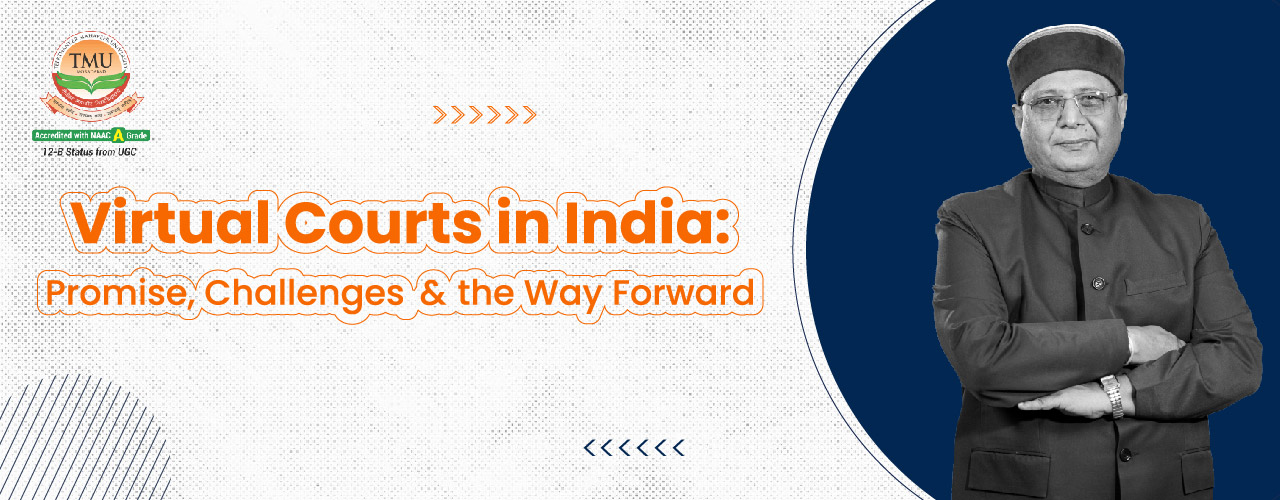Virtual Courts in India: Revolutionizing Justice or Undermining Its Foundations?
Table of Contents
By Prof. Harbansh Dixit
India’s virtual court system—initially born out of necessity during the COVID-19 pandemic—has sparked both optimism and legal concern. While some experts hail it as the future of justice delivery, others see it as a departure from the core principles of natural justice and open courts.
The Democratic Right to an Open Court
A key concern from legal thinkers is the lack of physical access to virtual courts, which, they argue, diminishes the public's participation and transparency in judicial proceedings. In a vibrant democracy, the common man should be able to walk into a courtroom, observe the judicial process, and feel included in the system.
Critics cite Article 145(4) of the Constitution, Section 327(1) of the CrPC, and Section 153B of the CPC, which emphasize that court proceedings should generally be held in open court. The concern is not just about access, but about ensuring that “justice is not only done but is seen to be done.”
Teerthanker Mahaveer University
Apply for Admission
Click Here To Apply for Admission
The Pandemic's Push Toward Digitization
During COVID-19, video conferencing and e-filing became judicial lifelines. Even remote regions gained access through tools like e-portals and online hearings. The government adopted these digital solutions for passport applications, Aadhaar authentication, and now judicial proceedings too.
According to official data, in just the first few weeks of the lockdown:
- Over 3,240 courts adopted video conferencing
- 1,272 jails were connected for virtual remand hearings
- Thousands of cases were resolved without physical movement
Virtual courts enabled faster, cost-effective, and safer access to justice.
Can Virtual Hearings Handle India's Caseload?
India's subordinate courts currently face a backlog of nearly 3 crore cases, out of which 60% involve minor civil and criminal matters. For many of these, virtual courts can serve as effective alternatives—especially in:
- Summary trials
- Consumer disputes
- Small claims and traffic violations
- Corporate and tax-related litigations
In these areas, oral arguments are minimal, and facts are clearly documented, making them ideal for virtual resolution.
Challenges to Virtual Court Implementation
Despite the promise, infrastructure bottlenecks remain. As per a standing committee report chaired by MP Bhupender Yadav:
- Only 3,477 of India’s 18,000+ courts have video conferencing facilities
- Many lawyers lack laptops, computers, or stable internet connections
- In rural areas, bandwidth issues disrupt audio and video clarity
- Data privacy, cybersecurity, and confidentiality concerns persist
These issues cannot be ignored while designing a sustainable virtual court ecosystem.
Legal Community Still Divided
Some members of the Bar argue that virtual hearings violate the spirit of courtroom access and may not work well for all types of litigation. Concerns also include:
- Intimidation of witnesses during remote cross-examination
- Undermining of courtroom decorum
- Reduced public scrutiny and media presence
Still, proponents maintain that hybrid models—with both virtual and physical components—can balance accessibility with integrity.
Future Potential: Virtual Courts Beyond the Pandemic
If virtual courts are integrated thoughtfully, they can:
- Reduce pendency by 50%
- Minimize unnecessary adjournments
- Allow litigants to hire lawyers from any part of India
- Lower travel and documentation costs
- Break geographical barriers and enable universal access to justice
The result? A leaner, more efficient legal system, especially for underserved populations.
A Literary Parallel: The Volga to Ganga Analogy
Just as in Rahul Sankrityayan’s “Volga Se Ganga,” where the character Yojana seeks permanence, settlement, and cultivation against her father's nomadic urges—virtual courts symbolize a forward-looking transformation, while skeptics cling to traditional norms.
The judiciary, like Yojana, must adapt thoughtfully to change, while acknowledging the practical constraints and ethical balance needed for a just future.
Conclusion: Towards a Hybrid Judicial System
The future of Indian judiciary lies not in abandoning tradition, but in evolving it. Virtual courts, if implemented correctly, offer:
- Faster access to justice
- Reduced judicial burden
- Empowered citizens and lawyers alike
A hybrid system—physical when needed, virtual where possible—may just be the next great leap in India’s judicial journey.















